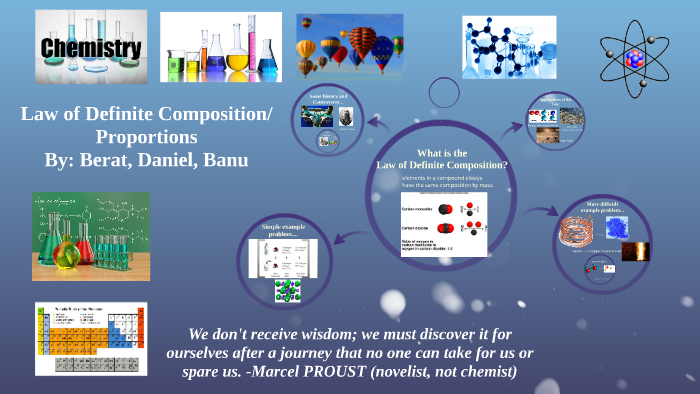Law Of Definite Composition
 Basic Concepts And Laws Of Chemistry Prezentaciya Onlajn
Basic Concepts And Laws Of Chemistry Prezentaciya Onlajn
The Law of Definite Proportions

Have you ever wanted to make more food than a recipe called for? Let's say you have a chocolate cake recipe that feeds four people, but you're going to a birthday party that will have eight guests. You will need to double the recipe, which also means you'll need to double the amount of eggs, sugar, flour, butter, milk and chocolate for the recipe. The amount of each ingredient will double, but the proportions should stay the same. We can think about this principle when defining The Law of Definite Proportions, which states that any chemical compound will always contain a fixed ratio of elements by mass.
A French scientist named Joseph Proust conducted experiments that demonstrated this law, from the late 1700's to the early 1800's. The Law of Definite Proportions is also sometimes called Proust's Law.
Examples of the Law of Definite Proportions
Let us take, for example, the compound, water. Whatever the source of water, its composition is that of two atoms of hydrogen and one atom of oxygen.
This figure shows that water, from any source, is always made up of two atoms of hydrogen and one atom of oxygen. If we calculate the molecular weight of water, we come up with 18 g/mol. In 1 mole of water, there are 2 grams of hydrogen and 16 grams of oxygen. By weight, we have a percentage of 11% hydrogen and 89% oxygen in one mole of water. This translates into a ratio of 1:8 of hydrogen to oxygen in water.
The Law of Definite Proportions illustrates that whatever the amount of water, whether it be 2 moles or 54 grams, the ratio of the amount of hydrogen to oxygen by weight will always be the same, just like the egg:sugar:butter ratio in chocolate cake should always be the same to maintain consistent taste.
Let's look at another compound made up of three atoms this time, such as ethyl alcohol, which consists of 2 atoms of Carbon, 6 atoms of Hydrogen and one atom of Oxygen.
According to the figure, we can calculate the percentage of each element in ethyl alcohol by weight, and we come up with 52% carbon, 13% hydrogen and 35% oxygen by weight. Based on the Law of Definite Proportions, the percentages of carbon, hydrogen and oxygen by weight in ethyl alcohol will always be the same, no matter what the amount.
Sample Problems
Let's look at some problems involving the Law of Definite Proportions in chemistry.
Problem 1
Sodium chloride, NaCl, contains 39% Na (sodium) and 61% Cl (chloride) by mass. If you have a 150-g sample of NaCl, how many grams of sodium and chloride are there in the sample?
Gallery Law Of Definite Composition
 The Law Of Definite Composition Introduction To Chemistry
The Law Of Definite Composition Introduction To Chemistry
 The Law Of Definite Composition Report The Law Of Definite
The Law Of Definite Composition Report The Law Of Definite
 2 1 The Atomic Theory Of Matter Chemistry Libretexts
2 1 The Atomic Theory Of Matter Chemistry Libretexts
 Law Of Definite Proportions Constant Composition Freakgenie
Law Of Definite Proportions Constant Composition Freakgenie
 The Law Of Definite Proportions Definition Examples
The Law Of Definite Proportions Definition Examples
 Chem1006 Lecture Notes Fall 2016 Lecture 6 Claude Louis
Chem1006 Lecture Notes Fall 2016 Lecture 6 Claude Louis
 Law Of Definite Proportions Lab Report
Law Of Definite Proportions Lab Report
 Law Of Constant Composition Or Definite Proportion Youtube
Law Of Constant Composition Or Definite Proportion Youtube
 Opinions On Law Of Definite Proportions
Opinions On Law Of Definite Proportions
 Law Of Definite Proportions Or Proust S Law Chemistrygod
Law Of Definite Proportions Or Proust S Law Chemistrygod
 Law Of Definite Composition Mgo Lab
Law Of Definite Composition Mgo Lab
 Early Ideas About Matter Chemistry Visionlearning
Early Ideas About Matter Chemistry Visionlearning
 The Law Of Definite Proportions Vs The Law Of Multiple
The Law Of Definite Proportions Vs The Law Of Multiple
 Welcome To Chemzipper Law Of Definite Or Constant
Welcome To Chemzipper Law Of Definite Or Constant
 Law Of Definite Composition Digital Portfolio
Law Of Definite Composition Digital Portfolio
 Solved Two Samples Of Sodium Chloride Were Decomposed Int
Solved Two Samples Of Sodium Chloride Were Decomposed Int
 Law Of Definite Proportions By Berat Gulecyuz On Prezi
Law Of Definite Proportions By Berat Gulecyuz On Prezi
 Solved The Law Of Definite Composition States That The Pe
Solved The Law Of Definite Composition States That The Pe
 Definite Proportions Multiple Proportions And Atomic Theory
Definite Proportions Multiple Proportions And Atomic Theory
 Law Of Multiple Proportions And Law Of Definite Proportions
Law Of Multiple Proportions And Law Of Definite Proportions
 The Law Of Definite Composition
The Law Of Definite Composition
 Law Of Definite Proportions Or Proust S Law Chemistrygod
Law Of Definite Proportions Or Proust S Law Chemistrygod
 Chemistry 11 Law Of Definite Composition Multiple
Chemistry 11 Law Of Definite Composition Multiple








0 Response to "Law Of Definite Composition"
Post a Comment